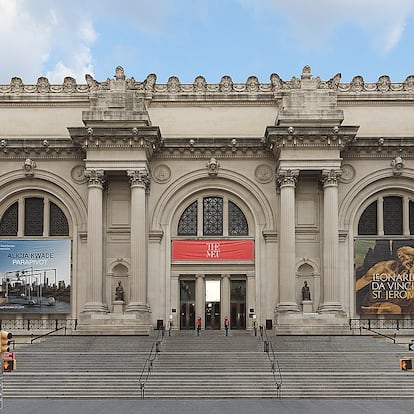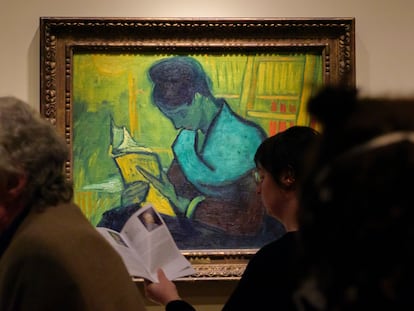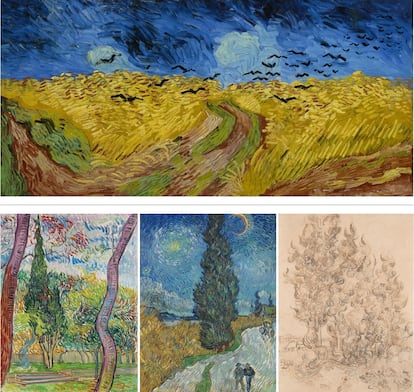
Van Gogh: The compulsive painter who died among his cypress trees
Two of the world’s most important museums have organized exhibits that depict the artist’s final productive burst in which he painted 124 works; many of them reflected his obsession with cypress trees
In the last two months of his life, Vincent van Gogh (1853-1890) produced 74 paintings and about 50 drawings during his stay in the French town of Auvers-sur-Oise, located about 25 kilometers from Paris. That amounts to an astonishing average of almost two works a day, including Wheatfield with Crows and Portrait of Dr. Gachet. It was during this period that Van Gogh focused some of his attention on cypress trees. “Shaped like an Egyptian obelisk,” as Van Gogh described the tree in a letter to his brother Theo, the cypress tree—which Catholics associate with cemeteries and which often appear on Mediterranean postcard landscapes—became an obsession as bleakness overtook Van Gogh. In Auvers, on July 27, he shot himself in the chest with a pistol.
Van Gogh died on July 29, at the age of 37. This period has been studied in depth from the perspective of the artist’s psychosis and the episode in which he cut off part of his own ear, which occurred a little earlier. Now, two exhibitions in different parts of the world focus on the work he produced during that time. At the artist’s museum in Amsterdam, canvases from his time in the French city are being brought together for the first time, while a show at the Met in New York displays the canvases on which Van Gogh reflected his obsession with cypress trees. The exhibitions represent two ways to remember Van Gogh’s tragic end.
The creative frenzy was cut short by a gunshot
Van Gogh Museum (Amsterdam)
Until now, there hadn’t been a retrospective dedicated to the crucial period that began with Van Gogh’s hopeful visit to the enclave visited by other painters including Corot, Cézanne and Pissarro. But the Dutch painter’s stay in Auvers ended in tragedy. For the first time, the artist’s museum in Amsterdam has brought together some of his paintings of houses, flowers, landscapes and some effigies in the exhibition Van Gogh in Auvers: His Final Months. This show features the works Van Gogh produced in a creative frenzy that was cut short when he shot himself in the same fields that had been such an inspiration for him. On display in Amsterdam until September 3, Van Gogh in Auvers was made possible by a collaboration with the Musée d’Orsay in Paris; the exhibition will move there in October.

In May 1890, Van Gogh arrived in Auvers from the psychiatric hospital of Saint-Rémy-de-Provence, in the south of France. While he was hospitalized, the artist had good periods as well as terrible crises, including two attempts to poison himself. At the same time, his work began to take off with critics. “One of them, Albert Aurier, lavished praise on Van Gogh by saying he was the heir to the Dutch old masters,” says Wouter van der Veen, a researcher and expert on the artist. Aurier published his article in January 1890 in the magazine Mercure de France; of Van Gogh’s work, he wrote: “The vehement passion of his drawings and coloring is not enough to explain his profound, complex and distinctive art.” The painter thanked the art critic in a letter, which his museum in Amsterdam acquired in 2019. In the missive, Van Gogh said that he found his own paintings “renewed, better than they really are, more valuable and more meaningful” after having read Aurier’s review.
Once he felt better, following a discussion with Theo, his brother and main supporter, Van Gogh put himself in the care of Dr. Paul-Ferdinand Gachet, a physician who specialized in nervous diseases. The doctor was also a patron of the arts and an amateur painter, and his house in Auvers was frequented by artists who later became Impressionists. Van Gogh liked the town. Much recovered, Van Gogh played around with blue and green tones and painted quickly and prolifically. “A creative community of Europeans, Americans and even a Cuban was formed, and Van Gogh wanted to prove himself in that environment. Spanish engraver Nicolás Martínez de Valdivieso had lunch with the artist several times at the Ravoux Inn, where Van Gogh was staying,” the expert explains. Van Gogh’s good spirits were reflected in his first works, which included depictions of the locality, chestnut trees in bloom and barges on the Oise River, and portraits like the Portrait of Adeline Ravoux, the daughter of the owner of the inn where he stayed. The church that he later made famous under a cobalt blue sky appears in the distance in several works.
That church was built in the 13th century, and in the piece it appears wrapped in violet reflections. “To the left of the viewer, we see a peasant girl with a headdress similar to those worn by the Dutch women of Brabant, where the artist was born. The use of color is striking…There are very famous paintings from this later period, as well as others that are little known; most of [the works] are in the United States,” explains Nienke Bakker, the senior curator of paintings at the Amsterdam gallery. The Musée d’Orsay loaned the painting of the church and seven others. Portrait of Dr. Gachet stands out among them. In it, the physician is seated and his head rests on his hand; his melancholy expression goes beyond an exercise in style. “The painter wanted to reflect ‘the broken soul of our time,’ and in his depression, Van Gogh identified with the widowed doctor,” she adds. The portrait featured in the exhibition is a second version that belonged to Gachet himself, whose family bequeathed it to the French state. The first version was auctioned in the United States in 1990 and acquired for $82.5 million by Japanese businessman Ryoei Saito. After his death, the painting went to new owners, whose identity is unknown. In Auvers, Van Gogh only signed the portrait of the girl Ravoux, and Bakker indicates that he did so for practical reasons. “They always misspelled his last name. It doesn’t look like he wanted to match masters like Rembrandt [Van Rijn].”
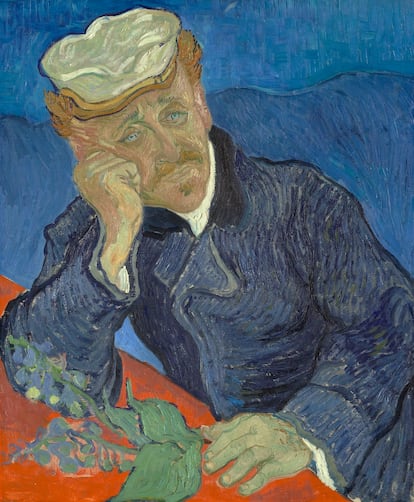
Between May and June 1890, the pace of Van Gogh’s production was such that he rushed out to the countryside to continue painting after leaving another canvas to dry. Surrounded by the 50 paintings and about 30 drawings now hanging in Amsterdam, Van der Veen says that he feels “glorious and a little overwhelmed” by the loans from museums and private collections that have made the show possible. Borrowed works have come from Austria, Finland, France, Sweden, the United Kingdom, Switzerland and the United States. The Gachet family was instrumental in preserving much of this production. During the painter’s funeral, his room at the Ravoux pension was full of paintings, and Theo told his acquaintances to take what they wanted. The doctor chose 27; it might seem like he took advantage, “but it kept the collection together and solidified Vincent’s reputation because other artists used to visit [Gachet’s] home,” Van der Veen says. “Although the Gachet family sold some pieces, they did not demand excessive prices for them. They later bequeathed 17 to the French state, and I think their contribution to Van Gogh’s fame has been underappreciated.”
Van Gogh’s initial clear skies and bright mornings started to darken, and the artist’s visit to his brother in Paris was the turning point that precipitated his demise. The date was July 6, and Theo and his wife, Jo Bonger, had just welcomed a son. Theo was ill (he died just six months later), and he was having trouble as an art dealer. Worried about his own future, Theo also lost a partner with whom he hoped to establish a business of his own. “Vincent did not perceive the needs of others and did not understand these tensions. He was swept up in an emotional whirlwind and believed that he was the problem because he depended on his brother’s help,” the same scholar says. Van Gogh’s series of panoramic paintings – ten of which are included in the exhibit - reflect his rapid slide into depression. “At times, he painted great life and bustle, [fields] in full harvest, but [at this point] his fields were empty. [His image of] City Hall on July 14, the French national holiday,[depicts] a deserted town square.”
The denouement came when he was busy with some acacia roots on the road to the Ravoux inn. In 2020, Van der Veen found a black-and-white postcard of the exact spot on the route in an Auvers resident’s collection; it now accompanies the painting Van Gogh left unfinished. The bullet fired into his chest could not be removed, and the painter asked to be left to die in peace. Theo embraced him until his last breath, and Dr. Gachet made drawings of Vincent’s face on his deathbed, which are also included in the exhibition. In Auvers, the owner of the land where the same roots still protrude has put up a fence to keep away the tourists.
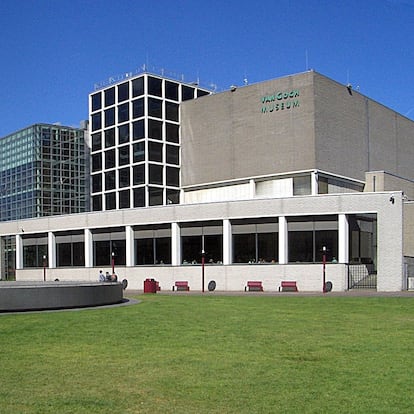
Van Gogh in Auvers: His Final Months
An obsession with obelisk-shaped trees
METROPOLITAN MUSEUM OF ART (NEW YORK)
During the last two years of his life, Van Gogh developed a special fondness for cypress trees as a pictorial motif. Van Gogh’s Cypresses, a monographic exhibition at the Metropolitan Museum of New York (Met), brings together all the Dutch painter’s works that depict the spindly tree, a flamboyant and almost spiritual figure that inspired dozens of Van Gogh’s paintings and drawings. Along with a wide selection of letters that reveal both his creative process and the demons that consumed him, the exhibition features approximately 40 works that will be displayed at the Met’s Gallery 199 through August 27.
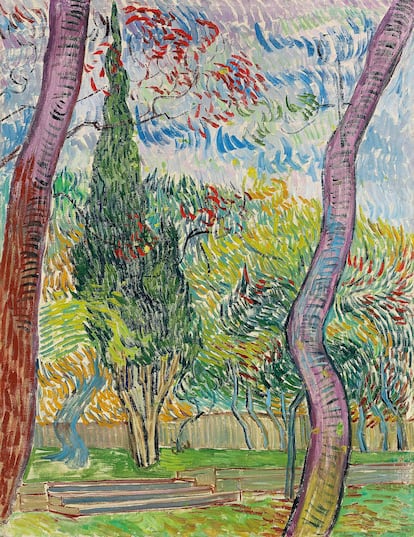
Van Gogh’s Cypresses is a moving, intimate and even painful exhibition: from the first canvases painted upon his arrival in Arles (France) in 1888, in which the cypresses appear in the background of still lifes, with trees full of fruit and fields in bloom, to the last paintings, in which day gives way to night or dense clouds (such as Landscape under Turbulent Skies, April 1889, private collection), the evolution of the artist’s mood and inspiration unfolds in a dramatic journey from color to black line, from light to twilight.
“This exhibition is a dream come true,” explains Max Hollein, the director of the Met. “Marking the 170th anniversary of Van Gogh’s birth, it brings together works that offer both an overview and an intimate approach to his creative process.” The juxtaposition of celebrated paintings with illustrated drawings and letters—many of which have seldom been exhibited together before—offers a different context for the post-Impressionist master, whose convulsive existence was oblivious to glory and fame.
After two years in Paris, Van Gogh arrived in the “glorious south” of Provence in February 1888. He went there with the idea of attracting other artists and forming a community of interests; in fact, his friend Paul Gauguin visited him in autumn of 1888. They lived together for nine turbulent weeks until the violent episode in December of that year, which ended with the Dutchman’s ear being cut off. February 1888 marked the beginning of a period of intense production—15 months of uninterrupted work—punctuated by two masterpieces, both from 1889, the year before his death: The Starry Night, which belongs to the Museum of Modern Art in New York (MoMA), and Wheat Field with Cypresses, owned by the Met. The two celebrated paintings had not been reunited since 1901. Now, they are the centerpieces of the exhibition, which also features oil paintings, watercolors and drawings, some of which have never been seen by the public before.


To understand the suffering that consumed Van Gogh during those two years requires delving into the details. To that end, the curator of the exhibition, Susan Alyson Stein, relied on the collaboration of some 30 galleries and collectors to put together the show. It is an epoch-making exhibition that rigorously debunks clichés about the Dutchman’s artistic career. “To find the true character of things, you have to look at them and paint them for a long time,” he wrote about his fixation with cypresses in another letter to Theo, in a constant dialectic between observation and reflection. From the moment he set foot in Arles, the painter explored the potential of introducing that “interesting dark note” (the cypress) into landscapes flooded with light, symbolizing the contrast of his own existence.
“It has always been thought that he discovered cypresses after his stay in the asylum, that it was what fueled his imagination and that he had more or less ignored Provence’s most striking motif before he got there. But that’s not the case,” the curator explained. Months before that first entry, in June 1889, the cypresses had already caught Van Gogh’s attention. They were a dark note that was increasingly present in a universe of light and color, Provence. In Arles, Van Gogh found the force of nature he was seeking, and the dark counterpoint of the cypresses served as a display of introspection amid the riot of color.
Cypress trees first appeared in Van Gogh’s work in a drawing from March 1888, around which the three-part exhibition is structured. The first part, entitled The Roots of His Invention, gathers the work he produced in Arles between February 1888 and May 1889: it is the most colorful section in which he discovers a lively landscape, as compared with the plains and weeping willows of the Netherlands (which he takes up again later in Memories of Brabant, painted between March and April 1890). After that first appearance as secondary characters, cypresses took center stage in Van Gogh’s work between May and September 1889, a period marked by his physical and mental deterioration. The exhibition calls that period The Making of a Signature Motif and situates it in Saint-Rémy. The loss of his ear in a confusing incident with Gauguin in December 1888 landed him in that town’s psychiatric hospital, where he continued to create indoors. In the third period, between October 1889 and May 1890 three masterpieces emerged amid intermittent institutionalizations and sickly walks in the countryside: the aforementioned The Starry Night, Wheat Field with Cypresses and the monumental Cypresses, in which trees were prominent. (The final part of the exhibition is called Branching Out in Style).
In that final period, in the hospice, Van Gogh closed the circle and recreated a huge cypress in a wheat field under a crescent moon and a star. Two works from May, A Walk at Twilight and A Country Road in Provence at Night, became his artistic testament. Even secluded within four walls, he painted, remembered and cited trees in his letters as if they were living beings. “I am amazed that no one has painted them as I see them,” he wrote to his brother Theo in one of his last letters. From the initial spell among the “tall, dark” trees, Van Gogh’s painting seemed to cling to the verticality of cypresses to shore up an increasingly broken personality. The cypress served as a metaphor, a banner as well as an obituary. According to a local obituary, on July 30, 1890, the coffin bearing his remains “disappeared between rows of cypress trees and huge sunflowers.”
